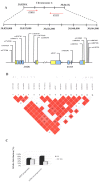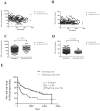Variants in ZNRD1 gene predict HIV-1/AIDS disease progression in a Han Chinese population in Taiwan
- PMID: 23874430
- PMCID: PMC3706582
- DOI: 10.1371/journal.pone.0067572
Variants in ZNRD1 gene predict HIV-1/AIDS disease progression in a Han Chinese population in Taiwan
Abstract
Patients demonstrate notable variations in disease progression following human immunodeficiency virus (HIV) infection. We aimed to identify ZNRD1 and RNF39 genetic variants linked to AIDS progression. We conducted a genetic association study in HIV-1-infected Han Chinese patients residing in Taiwan. The clinical characteristics of 143 HIV-1-infected patients were measured, and patients were split into 2 groups: AIDS progression and AIDS non-progression. Genotyping of ZNRD1 and RNF39 was performed in all participants. We found that patients in the AIDS progression group had higher HIV-1 viral loads and lower CD4 cell counts than did patients in the AIDS non-progression group. The frequency of the AA genotype of ZNRD1 (rs16896970) was lower in the AIDS progression group than in the AIDS non-progression group. Patients with AA genotypes had lower levels of HIV-1 viral loads and higher levels of CD4 cell counts than did patients with AG+GG genotypes. AIDS progression in patients with the AA group is significantly different from that in patients with the AG and GG groups by using Kaplan-Meier survival analysis. The hazard ratio for progression was lower in the AA group than in the AG and GG groups. We identified a SNP that contributes to AIDS progression in HIV-1-infected patients in this population. This SNP had a significant protective influence on AIDS progression, and polymorphisms of the ZNRD1 gene may play a role in the pathogenesis of HIV-1 infection.
Conflict of interest statement
Figures


References
Publication types
MeSH terms
Substances
LinkOut - more resources
Full Text Sources
Other Literature Sources
Medical
Research Materials

